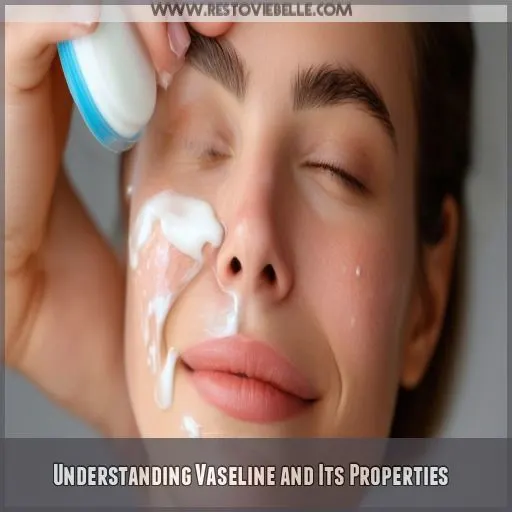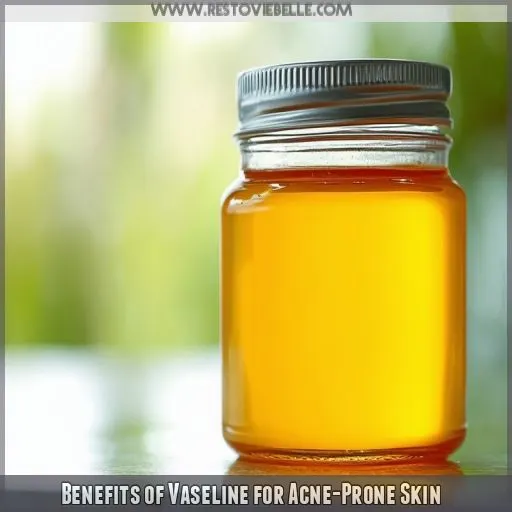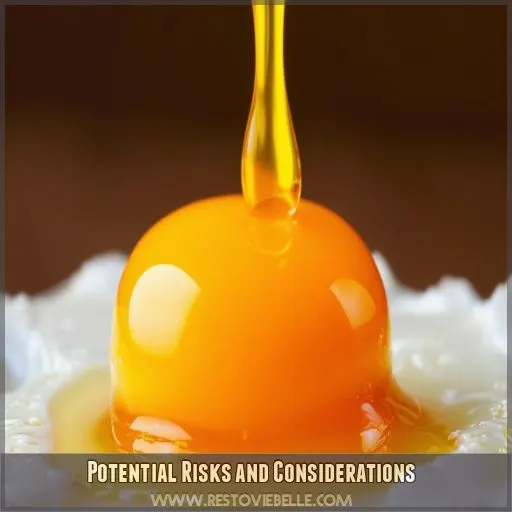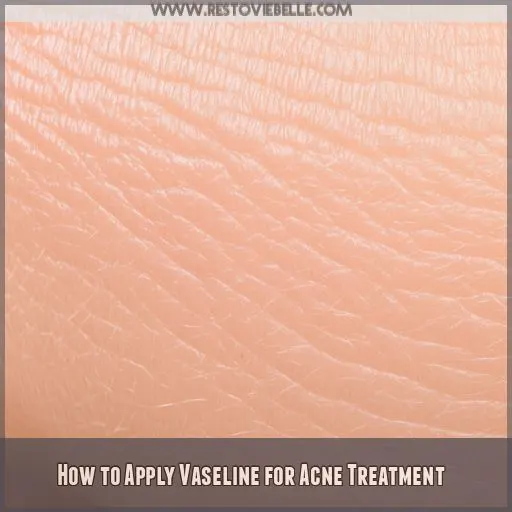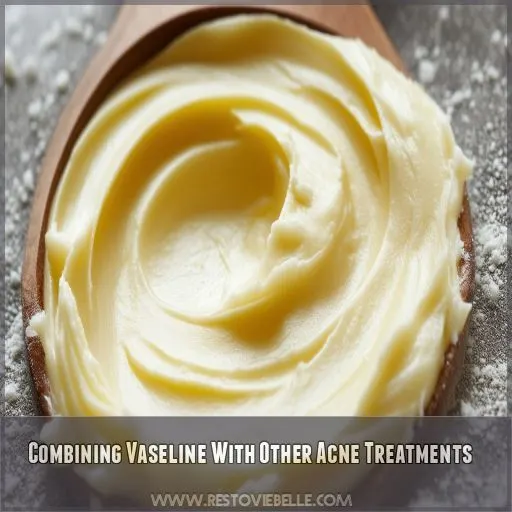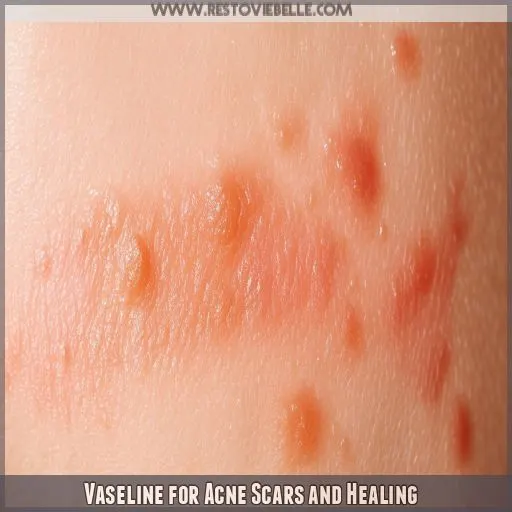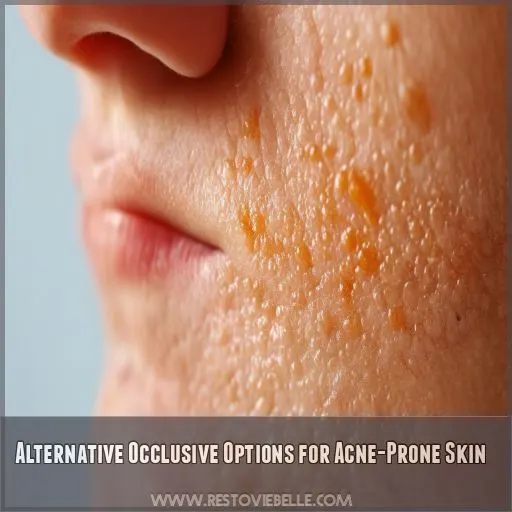This site is supported by our readers. We may earn a commission, at no cost to you, if you purchase through links.
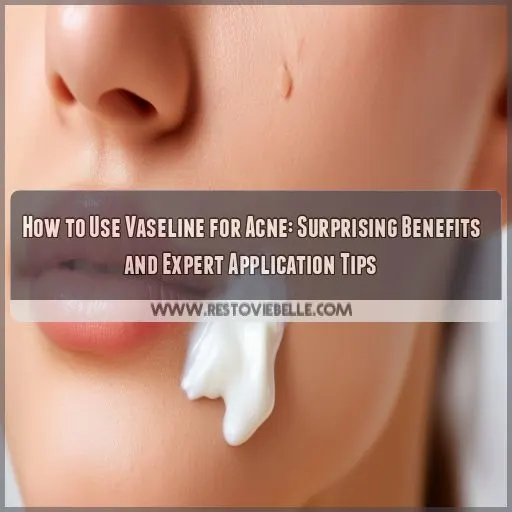
But how does one go about using Vaseline for acne effectively? This guide reveals expert application tips and unexpected advantages of putting petroleum jelly into your skincare routine.
You will learn to harness its occlusive properties, thus protecting the skin barrier and potentially reducing scarring. Master this unconventional acne treatment and learn to control your complexion.
Table Of Contents
- Key Takeaways
- How to Use Vaseline for Acne?
- Understanding Vaseline and Its Properties
- Benefits of Vaseline for Acne-Prone Skin
- Potential Risks and Considerations
- How to Apply Vaseline for Acne Treatment
- Combining Vaseline With Other Acne Treatments
- Vaseline for Acne Scars and Healing
- Alternative Occlusive Options for Acne-Prone Skin
- Frequently Asked Questions (FAQs)
- Is putting Vaseline on acne good?
- How to use Vaseline on face?
- Is Vaseline good for face overnight?
- Will slugging break me out?
- Can Vaseline be used as a spot treatment?
- How long should Vaseline be left on overnight?
- Is Vaseline effective for cystic acne?
- Can Vaseline be used under makeup?
- Does Vaseline work for back acne (bacne)?
- Conclusion
Key Takeaways
- Don’t judge a book by its cover – Vaseline may seem like an unlikely acne fighter, but this humble household staple has some surprising benefits for your skin. Its non-comedogenic nature means it won’t clog your pores, so you can say goodbye to those pesky breakouts!
- Less is more when it comes to applying Vaseline. A thin layer on damp skin is all you need to create a protective barrier that locks in moisture and shields your skin from irritants. Think of it as your face’s very own superhero cape!
- Timing is everything – apply Vaseline as the final step in your skincare routine, especially at night. This allows it to work its magic while you catch some z’s, giving new meaning to the phrase "beauty sleep."
- Don’t put all your eggs in one basket – while Vaseline can be great for acne-prone skin, it’s not a one-size-fits-all solution. Keep an eye out for any increased breakouts or irritation, and remember that what works for your bestie might not work for you. Your skin is as unique as you are!
How to Use Vaseline for Acne?
To use Vaseline for acne, start by cleansing your face thoroughly. Apply a thin layer of Vaseline to dry or irritated areas, focusing on acne-prone spots. It’s best to use it at night, allowing it to work while you sleep.
Vaseline’s occlusive properties can help lock in moisture and protect your skin from irritants. However, be cautious—overuse may trap oil and debris, potentially worsening breakouts. Monitor your skin’s response and consider a patch test first.
You can also layer Vaseline over acne medications to boost their effectiveness. Remember, everyone’s skin is different, so what works for some might not work for others.
Curious about maximizing Vaseline’s benefits for your acne-prone skin?
Understanding Vaseline and Its Properties
Vaseline, a petroleum jelly product, is non-comedogenic, meaning it won’t clog your pores despite its thick consistency. Its occlusive properties create a protective barrier on your skin, helping to lock in moisture and shield against external irritants that can worsen acne.
Non-comedogenic Nature
You might be surprised to learn that Vaseline is non-comedogenic, meaning it won’t clog your pores. This quality makes it a potential ally in your acne-fighting arsenal. Here’s what you need to know:
- Doesn’t block pores
- Allows skin to breathe
- Suitable for most skin types
- May help maintain healthy skin
While it’s occlusive and moisturizing, Vaseline’s non-comedogenic nature sets it apart from other petroleum jelly products.
Occlusive Properties
While Vaseline doesn’t clog pores, its occlusive properties make it a powerful skin ally. This petroleum jelly creates a protective barrier, sealing in moisture and enhancing healing. Let’s explore its effects:
| Effect | Benefit | Alternative |
|---|---|---|
| Moisture retention | Reduces TEWL | Hyaluronic acid |
| Skin protection | Shields from irritants | Silicone-based products |
| Enhanced healing | Speeds up recovery | Aloe vera gel |
You’ll find Vaseline’s occlusive effects particularly useful for dry, acne-prone skin.
Benefits of Vaseline for Acne-Prone Skin
Vaseline can offer surprising benefits for acne-prone skin, including moisture retention, barrier protection, and enhanced healing. By creating a protective layer, it locks in hydration and may help your skin repair itself more effectively, potentially reducing the severity and duration of acne breakouts.
Moisture Retention
Vaseline has significant occlusive properties, which help to lock in skin moisturizing. A thin layer will prevent water loss, lock in the hydration, and balance your oil production. This is a lightweight non-greasy overnight treatment for improving the health of acne-prone skin; it’s believed to deliver this by improving wound healing and ultimately decreasing scarring.
Barrier Protection
Vaseline creates a protective shield on your skin, guarding against environmental irritants that can worsen acne. While it may feel greasy, this barrier:
- Prevents moisture loss
- Shields from pollutants
- Protects healing pimples
Consider layering with non-comedogenic options if you have oily skin.
Enhanced Healing
Beyond protection, Vaseline accelerates healing and prevents scarring. It aids recovery by creating an ideal environment for your skin’s natural repair processes. Here’s how Vaseline compares to other treatments:
| Treatment | Healing Speed | Scarring Prevention |
|---|---|---|
| Vaseline | Fast | High |
| Stem Cell Microneedling | Moderate | Moderate |
| No Treatment | Slow | Low |
Potential Risks and Considerations
While Vaseline can offer benefits for acne-prone skin, it’s important to be aware of potential risks. You should watch for increased breakouts or signs of skin irritation, such as redness or itching, when using Vaseline as part of your acne treatment routine.
Increased Breakouts
While Vaseline isn’t comedogenic, it can still lead to increased breakouts for some. Its occlusive nature may trap oil and debris, causing skin congestion. If you’re acne-prone, consider alternative treatments or non-pore clogging options. Monitor your skin’s response closely, as Vaseline might exacerbate oil production in certain individuals. Remember, what works for one person may not work for another.
Skin Irritation
While Vaseline is generally safe, some people may experience skin irritation. Watch for signs of an allergic reaction, such as redness, itching, or swelling. If you notice any of these symptoms, discontinue use immediately and consult a dermatologist. Remember:
- Patch test before full application
- Start with a thin layer to gauge skin’s response
- Don’t use on broken or infected skin
How to Apply Vaseline for Acne Treatment
To effectively use Vaseline for acne treatment, start with a clean face and apply a thin layer to damp skin using your fingertips. Use Vaseline sparingly, focusing on dry or irritated areas, and apply it at night to allow it to work while you sleep.
Cleansing and Preparation
Cleanse the face with a mild, non-comedogenic cleanser before applying Vaseline. Pat dry your skin so that it’s still a little damp. Apply other acne treatments if prescribed and use them first. This will be important in preparing the skin to be adequately primed for the occlusive benefits of Vaseline.
Application Techniques
After cleansing, apply a thin layer of Vaseline to damp skin. Gently pat it on acne-prone areas, avoiding over-application. For enhanced benefits, consider layering Vaseline over other acne treatments. Its occlusive properties can boost their effectiveness while its non-comedogenic nature prevents pore clogging.
Frequency of Use
After applying Vaseline, don’t overdo it. Use it once daily, preferably at night. In summer, be cautious of sun exposure. During dry seasons, you might need it more often. If combining with other occlusives, adjust frequency accordingly to avoid clogging pores.
Combining Vaseline With Other Acne Treatments
You can enhance your acne treatment by combining Vaseline with other medications. Apply your acne treatments first, then layer a thin coat of Vaseline on top to boost their effectiveness and prevent them from rubbing off.
Layering With Medications
Timing is very critical when layering Vaseline over acne medications. Do this:
- Always apply the prescribed topical treatments first
- Wait 5-10 minutes for absorption
- Patetime with a thin layer of Vaseline all over the treated areas.
This can increase or diffuse the medications’ absorption, but it may also protect the layer. Be cautious of interactions or skin reactions that can occur from such polypharmacy. Consult your dermatologist before using Vaseline or combining it with your prescription acne treatments.
Boosting Effectiveness of Other Treatments
Vaseline can amplify the effects of your acne treatments. By sealing in other products, it enhances their absorption and longevity. Here’s how Vaseline boosts different treatments:
| Treatment Type | Effect | Application Tip |
|---|---|---|
| Spot treatments | Increases potency | Apply thin layer over |
| Moisturizers | Locks in hydration | Mix with Vaseline |
| Serums | Enhances penetration | Layer Vaseline on top |
| Exfoliants | Prolongs action | Use Vaseline as final step |
Vaseline for Acne Scars and Healing
Vaseline can help reduce the risk of acne scarring by creating a protective barrier that promotes proper healing. By keeping the skin moisturized and preventing scabs, it supports your skin’s natural repair process and may minimize the appearance of post-acne marks.
Reducing Scarring Risk
When using Vaseline with other acne treatments, consider its role in scar prevention. To reduce scarring risk, follow these steps:
- Apply a thin layer after your acne treatment
- Focus on inflamed areas to diminish redness
- Gently massage to improve skin texture
- Use consistently for best results
This method can enhance your skin’s appearance by creating a protective barrier, reducing inflammation, and supporting the healing process.
Promoting Skin Repair
Vaseline not only prevents scars but can also work to repair your skin if used correctly.
Vaseline works by placing a physical, impermeable layer on top of your skin, sealing in moisture needed for skin repair.
Apply a thin layer to any damaged areas after cleansing to lock in hydration.
Regular application enhances the skin’s natural repairing abilities and can gradually reduce the appearance of acne scars.
Alternative Occlusive Options for Acne-Prone Skin
If you’re seeking alternatives to Vaseline for your acne-prone skin, consider plant-based options like jojoba oil or aloe vera gel. These natural occlusives can provide similar benefits while potentially feeling lighter on your skin, making them worth exploring as part of your skincare routine.
Plant-Based Alternatives
Looking for Vaseline alternatives, plant-based occlusives offer natural remedies for acne-prone skin. These skin-friendly ingredients have similar benefits but minus the heaviness of petroleum jelly. Here are three non-comedogenic options:
- Jojoba oil : Laughably similar to your skin’s native sebum
- Rosehip oil, high in vitamins and antioxidants
- Aloe vera gel: Soothing and light in weight
These plant-based occlusives help to lock in the moisture while promoting your skin’s natural healing process.
Lightweight Occlusives
If you’re hesitant about Vaseline’s thickness, lightweight occlusives offer a great alternative. These products provide similar moisture retention benefits without feeling heavy on your skin.
Options like squalane, jojoba oil, and dimethicone create a breathable barrier that’s less likely to trigger breakouts. They’re non-comedogenic and can aid in healing while maintaining your skin’s natural balance.
Experiment to find your perfect match!
Frequently Asked Questions (FAQs)
Is putting Vaseline on acne good?
Vaseline can be beneficial for acne, but it’s not a one-size-fits-all solution. It may help protect your skin and lock in moisture, but it could also trap oil and bacteria. Consider your skin type before applying.
How to use Vaseline on face?
To use Vaseline on your face, cleanse first, then apply a thin layer to damp skin. Focus on dry areas, avoiding eyes and mouth. Use sparingly, especially if you’re acne-prone. Consider it as a final step in your skincare routine.
Is Vaseline good for face overnight?
You can use Vaseline on your face overnight, but it’s not for everyone. It’ll lock in moisture and protect your skin, but may feel heavy. If you’re acne-prone, proceed with caution and do a patch test first.
Will slugging break me out?
Slugging might cause breakouts if you’re acne-prone. It can trap bacteria and oils, potentially clogging pores. However, many find it beneficial. Try it on a small area first and monitor your skin’s reaction.
Can Vaseline be used as a spot treatment?
Surprisingly, Vaseline can be used as a spot treatment. While it won’t zap your zit, it’ll protect the area, lock in moisture, and prevent picking. Apply a thin layer overnight, but watch for breakouts if you’re acne-prone.
How long should Vaseline be left on overnight?
You can leave Vaseline on overnight for acne treatment. Apply a thin layer before bed and wash it off in the morning. This allows ample time for the product to work, locking in moisture and promoting healing.
Is Vaseline effective for cystic acne?
Ironically, Vaseline might seem like a miracle cure, but it’s not the silver bullet for cystic acne. While it can help protect your skin, it won’t treat the underlying causes. Consider consulting a dermatologist for targeted treatments.
Can Vaseline be used under makeup?
You can use Vaseline under makeup, but it’s not ideal for everyone. Apply a thin layer to dry areas before foundation. It’ll create a smooth base, but may increase shine. Test it first to avoid potential breakouts.
Does Vaseline work for back acne (bacne)?
Vaseline can help with bacne, but it’s not a primary treatment. You’ll want to apply a thin layer after cleansing to lock in moisture and protect skin. It’s best used alongside acne-specific treatments for better results.
Conclusion
Knowing how to use Vaseline for acne can be a game changer for your skincare. You have at your fingertips an all-rounder tool that won’t only protect your skin barrier and lock in moisture but also aid in potentially reducing scarring.
It indeed isn’t a miraculous cure, and application with caution on the skin is required. Adding this humble drugstore staple into your arsenal just may bring surprising benefits.
REMEMBER: To consider risks. Apply properly. Combine with other treatments if necessary.
Applied carefully, Vaseline could prove to be that secret weapon against acne and its residual effects.

